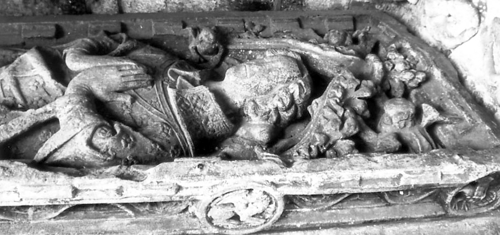 |
YORKSHIRE - THE EAST RIDING |
 |
| I have not really done justice to the old East Riding: many of the photographs are old black and white ones, often there are just lists of monuments and my own photographic skills were rather lacking twenty years ago, which I will blame on the lack of a sufficiently wide angle lens for interior shots. Those I have taken were during the Church Monuments Society symposium at Beverley in 1996; not the best time to take photographs! |
|
|
|
||||||||||||
| Bainton - St Andrew |
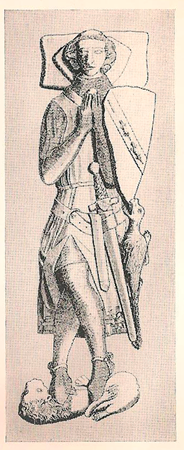 |
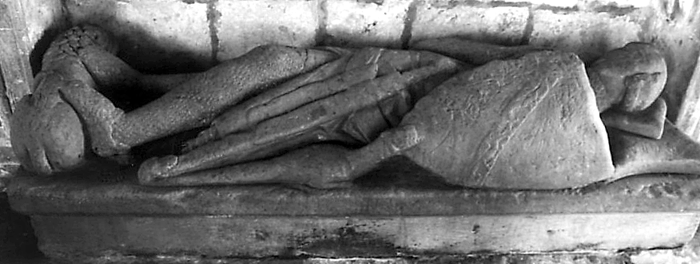 |
 |
|
Sir John de Mauley,
Rector (1331) Knight in contemporary recess. On the
canopy angels hold soul in napkin.
(shown above and left) Roger Godeale, Rector (1429) brass; holds chalice. (shown right) Robert Faucon (1661) Tablet with falcon (rebus),skull and angel's head. Inscription gives date 1640. Robert Grimston (1756) & Elizabeth (1771) Two marble tablets with obelisks |
| BEVERLEY |
|
Beverley was one of the 'Six More English Towns' chosen by Alec Clifton-Taylor in the BBC Television series and is certainly worth a vist and a wander around. It has not just one but two magnificent churches as well as a remarkable number of pubs; the handful I have visited were rather good. Plus - and I hope it is still there - an excellent ice cream shop - Burgess & Son (just inside the bar) |
 |
Beverley Minster |
| The Parish Church of St John of Beverley
and St Martin of Tours It was originally a collegiate church |
| Retrochoir |
 |
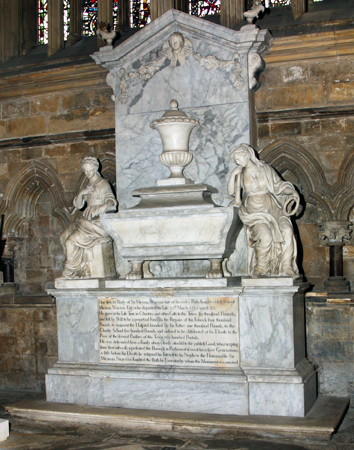 |
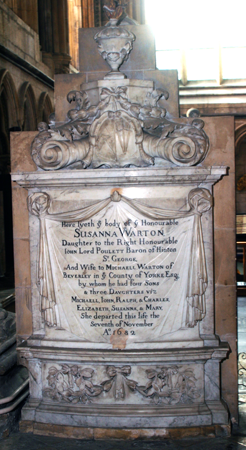 |
 |
| Sir Michael Warton (1655) Attributed to Thomas Stanton. | Sir Michael Warton (1725), By PeterScheemakers, 1728-32. | Susanna Warton (1682) by William Stanton | Michael Warton (1688) by William Stanton. |
| Other Monuments |
| John Warton (1656) , inscription on drapery. Attributed to Thomas Stanton |
| North Choir Aisle & North-East Transept |
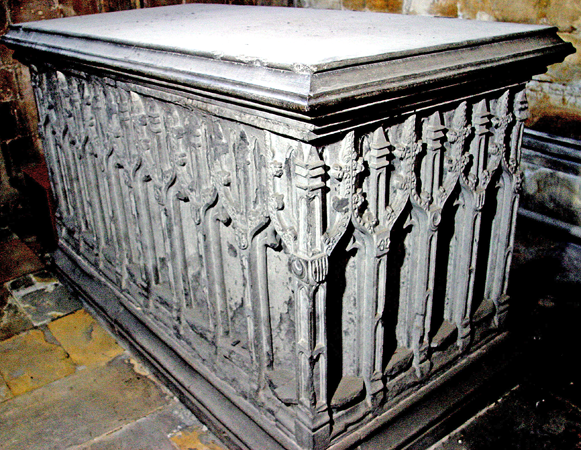 |
 |
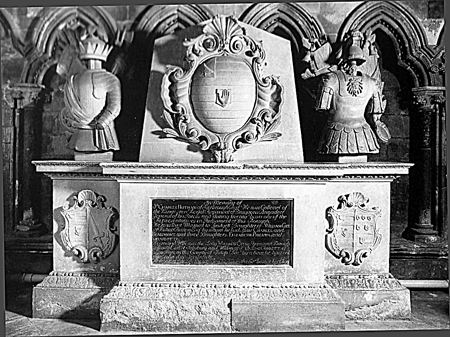 |
| Henry Percy, 4th Earl of Northumberland (1489) No effigy and the canopy was demolished in the early 18th century. The Earl famously held back at the Battle of Bosworth, failing to support and so contributing to the defeat of King Richard III. He was murdered by a mob at Topcliffe a few years later. | Sir Charles Hotham (1723) Standing monuments in the centre of which a shield in a cartouche and to each side free standing arrangements of armour, originally much higher but truncated at the suggestion of Sir G G Scott. On the left is more recent photograph but the monument is obscured by paraphenalia; on the right a black and white photograph aken with a wide angle lens. | |
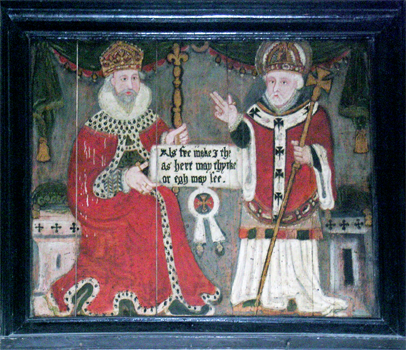 |
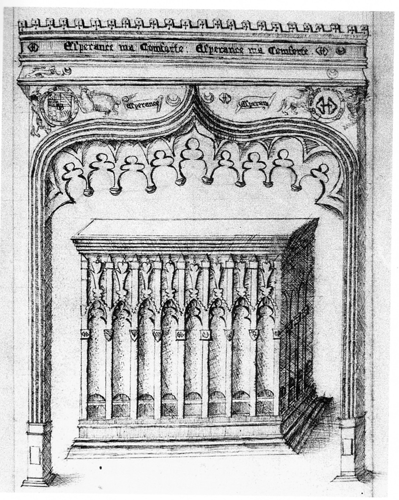 |
 |
| Above:
Is this the memorial to Rev Giles Fleming (ob 1665)
referred to in Pevsner's
Yorkshire: The East Riding, where it is described as a
painted wooden board with rhyming
inscription but anonymous. Right: The Percy tomb with its canopy, with odd proportions and perspective Far right: Walter Strickland (1780) By PeterChenu of London. |
| Other Monuments |
| Mary Canham (ob 1795) urn on obelisk. By Fisher of York. |
| North Transept - North Doorway |
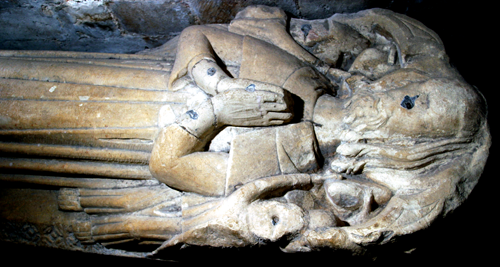 
 |
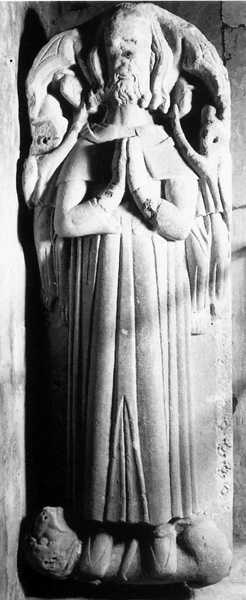 |
| Above top and right:
Civilian Male c 1360. Above bottom and below: Nicholas de Huggate (1338) Effigy of priest in mass vestments. Many heraldic shields. The tomb chest is from another monument and may belong to the canopy in the nave. Note the fine carving of the details on the ecclesiastical vestments. The above lithograph by R Martin for Scaum's Beverlac (1829) is clearly labelled 'The Percy Tomb'; However, it is clearly the Huggate tomb. Excellent drawing however. |
|
 |
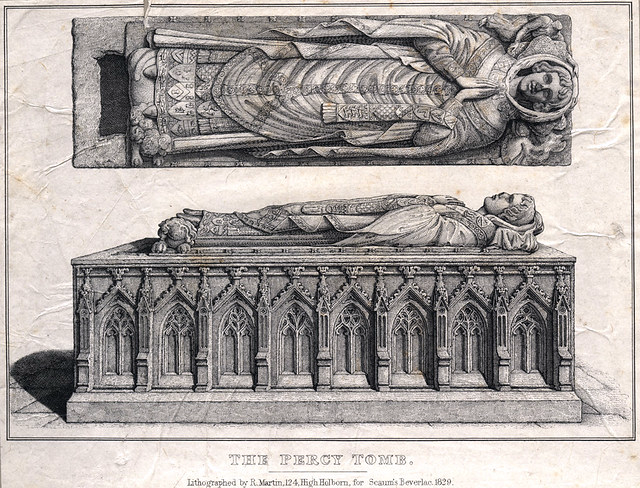 |
| Other Monuments |
|
Tomb chest with back
wall with brass indent. Purbeck, very
decayed. Ebernezer Robertson (1825) by Knowles of Oxford John Storm (1832) by George Earl Jnr James Edmonds (1776) urn |
|
|
||||||||||
| The Choir |
 |
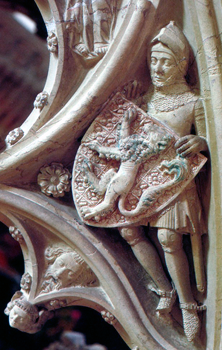 |
 |
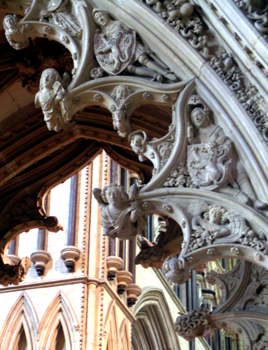 |
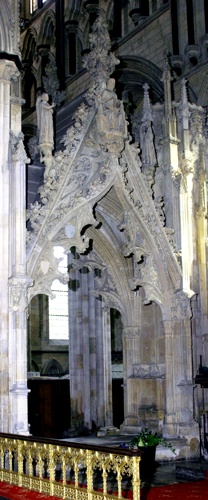 |
| Lady Eleanor Percy (1328) This is the famous Percy Tomb, said to be the most splendid of British Decorated funerary monuments, but the attribution is uncertain; heraldry, however, makes a date after 1339 likely. There is no effigy but the top slab of the tomb chest which was removed in 1825, in the amost certainly mistaken belief that this was a later addition, bore the indent of a brass of a priest | ||||
| Beverley - St Mary |
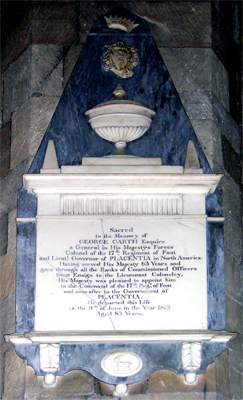 |
 |
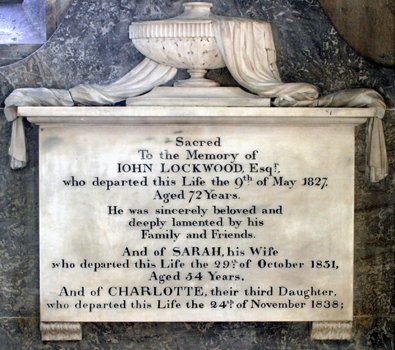 |
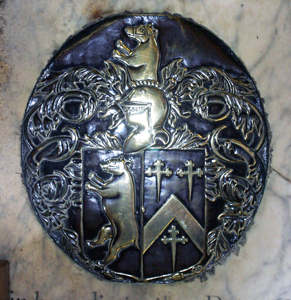 |
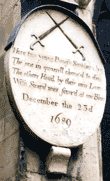 Here two young Dasifs Souldiers lye. The one in quarrell chanc'd to die; The other Head, by their own Law With Sword was fever'd at one Blow December the 23rd 1689 |
| Far left: General George Garth (1819). Col 17th Reg of Foor, Lt Governor of Placentia in North America. Left: Ralph (1768) & Bridget (Gee) (1774) Signed: (Edmund) Foster HULL fecit. Above left :John Lockwood (1827), his wife, Sarah (1831) and daughter, Charlotte (1838). Above centre: Sir Edward Barnard (1686) marble floor slab with inlaid brass roundel with arms. Above right: Tale of a Beverley murder and execution. On the exterior of the S chancel aisle, monument to two Danish soldiers, one of whom was executed for killing the other. The inscription is given above. | ||||
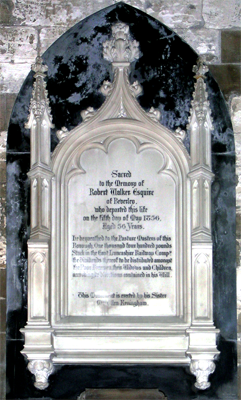 |
 |
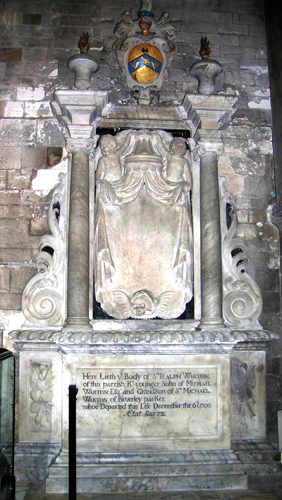 |
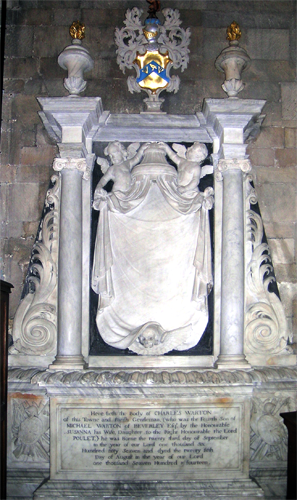 |
 |
|
|
Robert Walker
(1856) by R Whitton |
Ralph Wharton
(1709), 3rd son of Michael & Susanna Wharton Attributed to William Woodman the Elder. |
Sir Ralph
Warton (1700), Similar and
also by Woodman. Younger son of Michael and grandson of Sir Michael |
Charles
Wharton (1714) Similar and
also by Woodman. 4th son of Michael & Susanna Wharton |
Robert
Kennington (1859) by R Whitton |
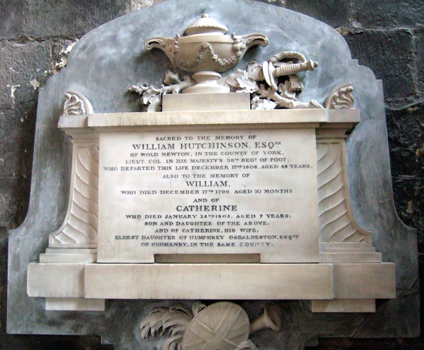 William Hutchinson (1808) Lt Col in HM 36th Regt of Foot Also his children: William (1790) at 10m; Catherine (1803) at 7 years And his wife: Catherine (Osbadeston) [n/d] Signed: Bacon, London, Samuel Manning fecit |
 Elizabeth Stephenson (1856) And her husband John Stephenson (1867) |
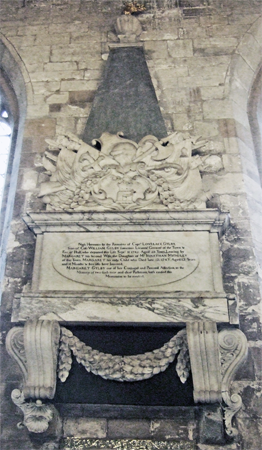 Cptn Lovelace Gylby (1743) and his daughter by his second wife, Margaret, Margaret (1747) aged 12 |
 |
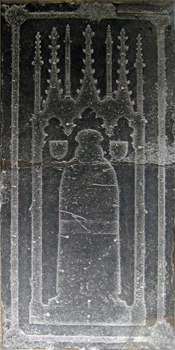 |
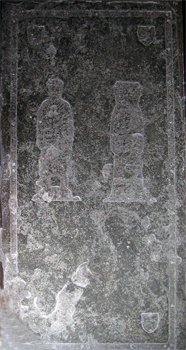 |
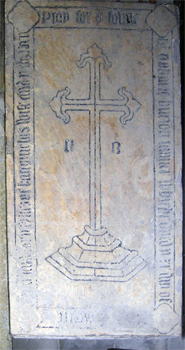 |
 |
| The cross slab above is to Robert Burton (1535). The two ledger stones are to the two wives of Captain Lovelace Gylby: Margaret (Barnard) (1720) and Margaret (Midgely) (1790); Capt Gylby died in 1745 and his monument is shown above | ||||
| Other Monuments |
| There are many floor
monuments - brass matrices, incised slabs and ledger stones - a
few of which are shown above.
There are also many
fragments in the priests' room including a 13th century
floriated slab and a marble inscription to Francis Drake (1771),
author of Eboracum, whose son was vicar here. |
| Thomas Terry (1804) Midshipman on HMS The Cary's Fort. He died ages 17 at Monserrat in the West Indies. Oval tablet with long axis vertical | Robert Cheney (1820) Lt Gen in the Army. He died of typhus at the age of 54. The tablet describes his military career.'...remains are interred in a vault below this chancel.' Simple white rectangular tablet; long axis vertical. |
| Samuel Butler (1812) with the quotation: 'A poor Player...' Simple white oval tablet with long axis horizontal. | Wiliam Wilson (1816) A list of charitable bequests. Plain rectangulat tablet |
| Richard Grayburn (1720) | William Stephenson (1836) Upturned torches. By Whitton |
| Mary Boldero (1753) With broken pediment |
| Beverley Friary |
| Now restored as Youth Hostel; near the Minster |
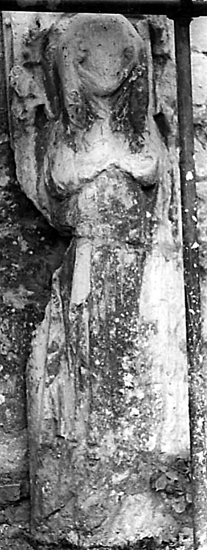 |
 |
| Lady (c 1310), effigy east of porch. Outside but now protected by a wooden canopy since the first photograph was taken. May be easily visited. | |
| Birdsall - St Mary |
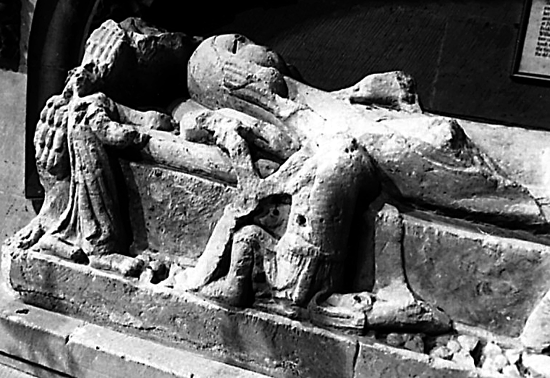 |
Lady (14th century)
effigy with kneeling mourners
on the lateral sides. (shown) Henry Southeby (1662) black tablet Ann Southeby (662) black tablet with drapery Thomas Southeby (1729) Large pedimented tablet signed by Michael Rysbrack Sixth Lord Middleton (1835) Kneeling woman in white marble by Richard Wesmacott Charlotte Willoughby (1814) tablet with draped urns by Waudby of York Henry Willoughby (1845) identical to the above |
|
|
||||||||
| Burton Agnes - St Martin |
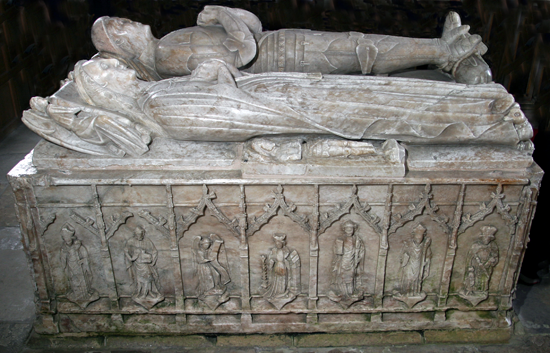 |
 |
 |
| Above: Sir Walter Griffith (1481) & Wife, Alabaster knight and lady on a tomb chest with fourteen figures under ogee gables: Annunciation, female saints including St Anne teaching Virgin to read, male saints and angels with shields. Also a figure of a child as a knight lies next to mother, having been originally next to his father but was moved when the female figure, originally in this position, was stolen. Right: Cross slab in church yard. | ||
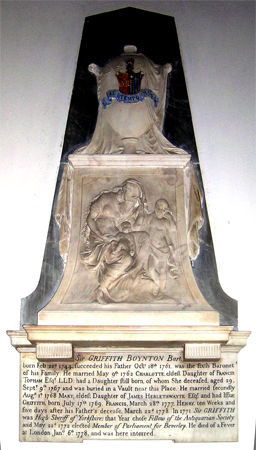 |
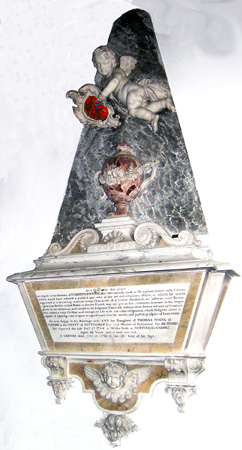 |
 |
 |
| Above left: Sir Griffith Boynton Bt (1778) Relief of young female with children. Above centre: Sir Griffith Boynton Bt (1761) Coloured marbles; by Sir Henry Cheere, 1763. Above right: Sir Henry Griffith Kt (1620) and his wife Elizabeth Far right: Sir Henry Griffith Bt (1654) & Two Wives (a Willoughby and a Bellingham) Instead of effigies are three black coffins. On the tomb chest a still life of skulls and bones. | |||
| Other Monuments |
| Sir Roger de
Somerville (1337), Tomb chest with
quatrefoils, so attributed by 18th century tablet. Rev George Burghope (1727) Stone architrave Thomas Dade (1759) Tablet with urn and obelisk, very fine Ann Cayley (1769) Similar to above but poorer, by Fisher Elizabeth Moshum (1820) Oval tablet by W Ward of Scarborough |
|
|
||||||||
|
|
|
 |
Etton - St Mary |
 |
 |
 |
 |
  Above top: William Wilson (1816) There is then a list of his charitable bequest in his will. By Rushworth Above bottom: Rev John Lothorpp (1653), who was baptized here in 1584 and became pastor at Scituate and Barnstable, Plymouth Colony, Massachusetts 1634-53. He was buried at Barnstable. By Ronald Sims (1981) |
From left to right above: 1. Ledger stone which can be seen behind the pews on the right of the interior photographs. The Inscription reads, on the top: Here Lieth Intered ; and then around going around the edges: The Body Of The Worspl (Worshipful) Ald: (Alderman) Towers Wailis / Merchant And Once/ Mayor Of The Town Of Kingston Upon. Now we return to the top below the initial inscription: Huil Who Departed The Life On The 12 Day Of April 1719 In the [59] Year Of His Age. Then below the arms it reads: Also His Daughter Mrs Ann Porter 1760. 2. Bridget Domelow (1680) who married firstly Edward Dickenson of Farnborough, Hampshire, and, secondly Dr Iohn Domelow, rector of Hamelton, Bucks. Also Mary Delgano (1693), wife of Arthur Delgano, Rector. Also Lucy Canon (1694), wife of Thomas Canon, Rector of Church and Chapell of Brampton. Also Elizabeth Delgano (1724), second wife of Arthur Delgano, Rector. Below on a separate tablet, Mr Arthur Delgano (1730) Rector. Below, on a black tablet, is written in Latin in hope of resurrection. 3. Rev Henry Robinson (1761) Rector of Skerrington, Yorkshire. 4. William Kirkby white lead worker, and his wife, Dorothy. Also their daughter, Anne Outram (1771) , wife of Ioſeph Outram, wine merchant. 5. (below the above two) Rev John Dand (1817) Ten weeks curate of this parish. Aged 32 |
|||
| Also (not shown);Effigy
of a lady, late 13th or early 14th century, which was removed
(after 1972) to the church yard and subsequently partly
destroyed. Two fragments, the lower parts with feet resting on a
dog and part of a shoulder with two shields, survived and are
now in the church. There is also recorded in Pevsner (revised by David Neave): 1. Mrs Frances Legard (1800) By Taylor of York. 2. Joseph Outram (1779) 3. Joseph Outram (1802). One is presumably the aforementioned Joseph Outram, wine merchant. |
 |
Harpham - St John of Beverley |
 |
| A Lady (1360-70) |
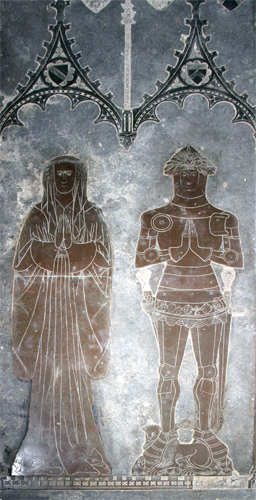 |
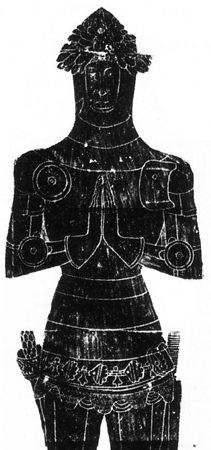 |
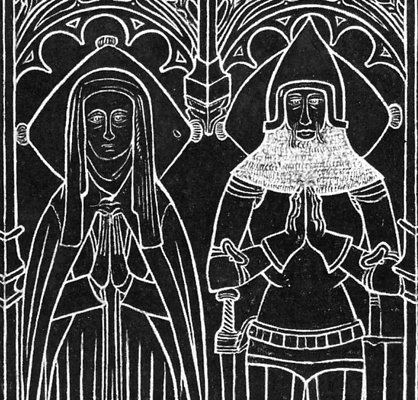 |
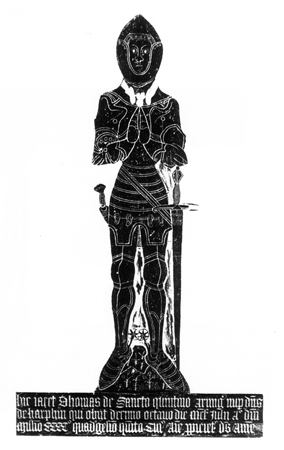 |
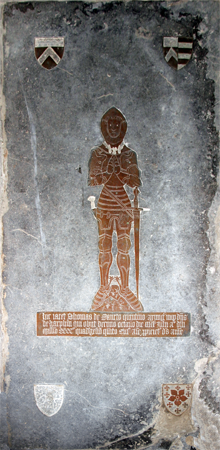 |
| Above
left: Sir Thomas de St Quintin
(1418) & Wife. Rubbing
of part of male figure from the male figure
detail from knight/lady brass set under a double canopy.
There is a somewhat cropped photograph of this brass to
the left. Very fine work. Above right: . c.1400. Rubbing of part of incised figures under a canopy from an alabaster tomb chests; the chest itself has quatrefoils flanking a crucifix. A photograph shown below. Probably set up by the St Quintin Rector of Hornsea and is similar. Right: Thomas de St Quintin (1445), brass rubbing. A photograph to the far right |
||||
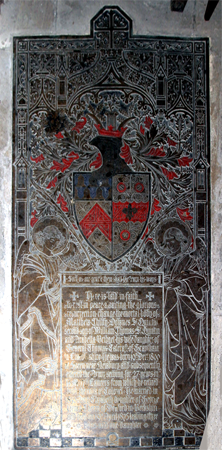 |
 |
 |
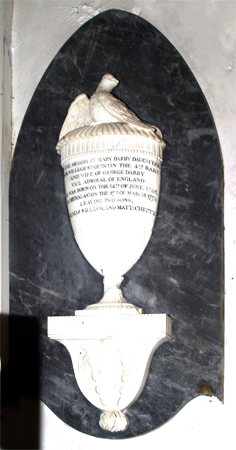 |
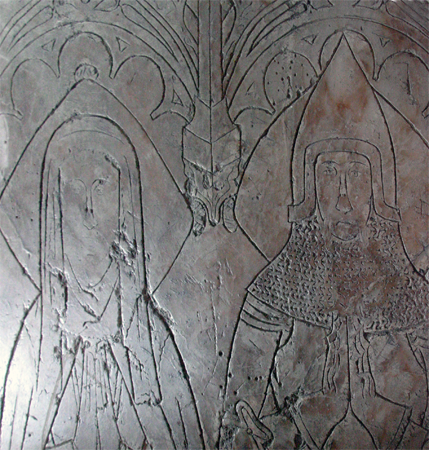 |
|
Mathew Chitty T St
Quintin (1876) Brass by Matthews & Sons of London |
The entrance to the St Quintin vault. Built 'by order of' William St Quintin 1827: closed 1887. | Mathew Chitty St Quintin (1785) Coloured marble |
Mary Darby
(1773) by J Fisher of York |
William de St Quintin
(1349) & Wife See above. All I could get at the time! |
 |
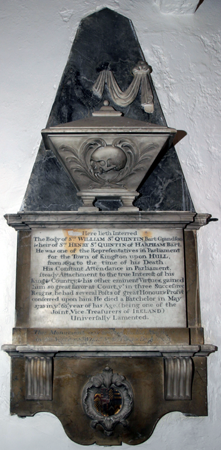 |
|
||
| Charlotte St Quintin (1762) large standing angel by urn with double portrait medallion; by Joseph Wilton | Sir William St Quintin (1723) marble with sarcophagus and skull, erected 1768 |
 |
Hessle - All Saints |
 |
 |
 |
 |
| Captain Joseph Boulderson (1828) Of the Honorable East India Company |
John Barkworth (1815) and
his wife, Elizabeth (1838) |
William Burstall (1852) He died on a sea voyage to Melbourne at 18; buried at Port Adelaine |
Alexander Smith (1927) and
his wife, Ada (Walker) (1916). Dated 1971 |
 |
Hornsea - St Nicholas |
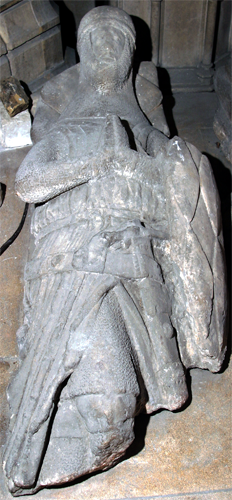 |
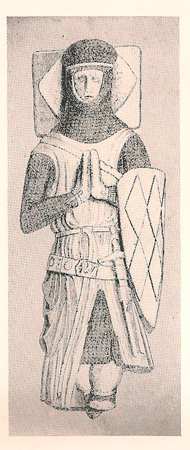 |
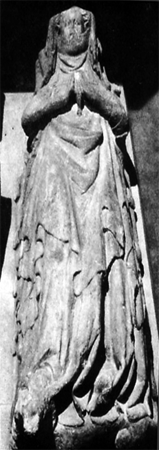 |
  |
A Fauconberg (William) of Catfoss, knight, cross legs, c. 1320. Brought from Nunkeeling. Also side by side: Isabella de Forz, Countess of Aumale (1293) or Amicia, Countess of Devon (1284), the former the mother and the latter the grandmother of Aveline, Countess of Lancaster, whose tomb in Westminster Abbey is similar. (c 1290 )and very fine. Also brought from Nunkeeling. |
|||
 |
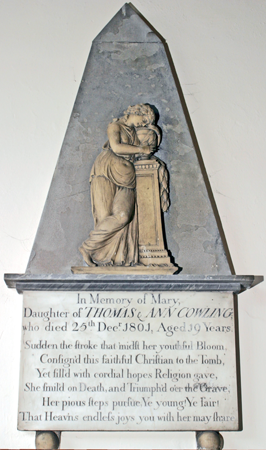 Mary Cowling (1801) She died on a Christmas day, aged 19 |
|
||
 |
||||
| Top:
Anthony St
Quintin, rector, (1430). Incised
effigy on alabaster tomb chest with shields
in quatrefoils, c. 1400 (ie before he died) Bottom: Civilian, c. 1330 in cape and hood. Brought from Goxhil |
| Howden - St Peter |
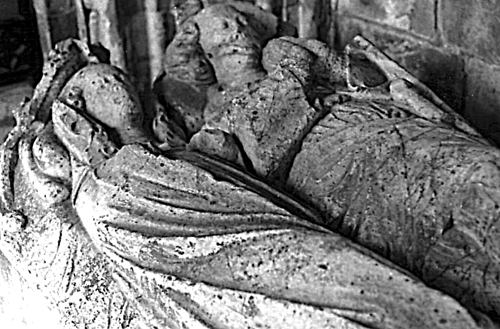 |
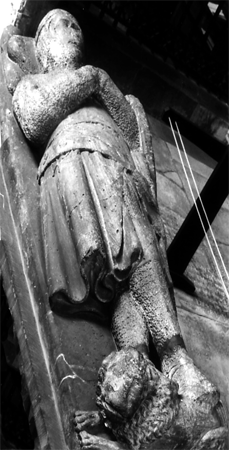 |
 |
| Above:
Sir John
Metham (1312) and Sybyl.
Knight with crossed legs and lady under a mid 14th century
tomb recess which does not belong; they were formerly on a tomb
chest in the middle of the chapel. Right: Sir Eluard Saltmarshe (1322) knight with crossed legs now on the tomb chest with weepers referred to left. |
| Other Monuments |
|
Walter Kirkham, Bishop of Durham (1260). A coffin lid of Frosterley Marble from County Durham, with a cross in relief and inscription recorded; unusually, a viscera burial. Cross slab (1300) with arched base containing female figure Johannes Cole (1467) Incised slab with cross, chalice and missal Knight (1480) Brass John Saltmarshe (1533) Incised slab Mary Rawson (1787) Roundel with female figure in relief Ann Whittaker and others (1794- 1803) Sarcophagus with obelisk by Willoughby of Howden Catherine Saltmarshe & others (1807-11) by Fisher of York. Ann Spofforth (1824) Tablet with urn Thomas Carter (1829) Tablet by Waudby of York Elizabeth Saltmarshe (1837) 17th century style tablet by J Browne, London 1847-48 Philip Saltmarshe (1846) Ornate Gothick by J Browne, London 1847-48 Arthur Saltmarshe (1864) Gothick by Bedford of London Arthur Saltmarshe (1909) Gothick Philip Saltmarshe (1912) Gothick R S Scholfield (1913) edger stone by Eric Gill Also: many floor slabs, five brass indents and reused medieval gravestones. 17th - 18th century ledger stones |
| HULL |
| Kingston upon Hull A fine collection of monuments in a city where initially one would not expect to find them |
| Hull - Holy Trinity |
| Other Monuments | |
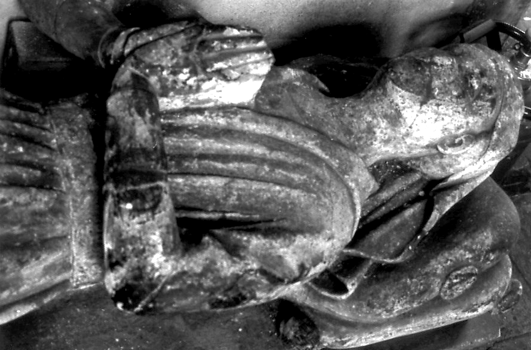 Sir William
de la Pole (1366) & Katherine ( 1381)
,
traditional identification of the
alabaster effigies of a merchant and wife in
canopied niche
. (part shown left) Sir William
de la Pole (1366) & Katherine ( 1381)
,
traditional identification of the
alabaster effigies of a merchant and wife in
canopied niche
. (part shown left)Sir Richard de la Pole (1345) Uncertain. In canopied niche leading into Broadley Chapel, originally the de la Pole Chantry Chapel. Restored shields suggest a de la Pole. Canopy influenced by Percy Tomb at Beverley; renewed in 1863 Richard Byll (1451) and Wife. Brass half effigies (civilian) with merchant's mark and black letter inscription Lady (late 15th century) Thomas Dalton (1591) and Wives Incised slab with inlaid shields Thomas Whincop (1624) Tablet with bust and flanking black columns, open pediment Thomas Ferrers (1631) Angel giving man a drink; bust of the commemorated. By Thomas Earle of London, 1859 John Huntington (1790) Oval tablet by Edmund Foster Nathaniel Maister (1772) Medallion with female figure with urn Rev Thomas Milner (1797) Wall tablet with figure of Moses by John Bacon Jnr Thomas Gleadow (1814) Sarcophagus with urn on obelisk |
John Appleyard (1860)
Kneeling female figure by Thomas Earle
of London. Henry Maister (1812) Sarcophagus surmounted by a crossed sword and spear framed by gothic arch by John Earle Joel Foster (1820) Inscription on drapery hanging from canopy surmounted by an urn Anthony Scales (1824) Sarcophagus, urn and weeping willow John Alderson (1829) Portrait medallion with two female figures by William Behnes William Wooley (1837) Free standing bust on pedestal by W D Keyworth George Lambert (1838) - Organist tablet with the church organ by John Earle John Cowham Parker (1841) Gothick marble tablet John William Grey (1860) Angel with drowned boy and infant by Thomas Earle John J Matthewson (1863) Tablet with Moses striking the rock for water. Mr Matthewson was responsible for securing Hull's water supply John Smith (1875) Georgian tablet designed by Ronald Simms and executed by Dick Reid William Thomson, Archbishop of York (1890) Portrait medallion Rupert Alec-Smith (1983) Georgian tablet designed by Ronald Simms and executed by Dick Reid Many 17th to early 18th century black ledger stones with deeply incised arms. Such stones may have been imported, partly cut, from Holland. John Ramsden (1637) & Wife, Incised slab Anthony Lambert (1688) Cartouche with angels' heads and winged skulls Henry Maister (1699) Similar to the above Giliad Goch (1700) Cartouche with angel's head and crest William Maister (1716) Corinthian pilasters and broken pediment. Attributed to Robert Hartshorne Mark Kirby (1718) and Daughter Inscription on drapery hanging from a canopy; by Robert Hartshorne William Skinner (1724) Putti and pediment Thomas Earl (1876) Two mourning females by urn. by himself |
| Hull - St Mary |
| Lowgate |
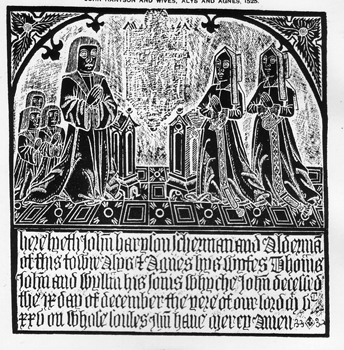 John Harrison (1525),
wives, Alys and
Agnes and sons, Thomas,
John & William.
A Wool draper.
English Brass but this is an early
plate rather than a cut out John Harrison (1525),
wives, Alys and
Agnes and sons, Thomas,
John & William.
A Wool draper.
English Brass but this is an early
plate rather than a cut outThomas Swan (1630) & Wife and children. Incised slab inlaid with white composition. William Dobson (1666) Frontal bust in classical arch, flanked by putti with cartouches of arms, skulls, swags and drops carved with fruit and flowers. Alabaster. Decorative wrought iron work below Robert Hildyard (1683) Black marble ledger stone with arms Jonathan Beilby (1711) Cartouche with cherubs' heads Philip Wilkinson (1716) Cartouche with cherubs' heads, winged skull and lamp Benjamin Blaydes (1771) Oval tablet Sir Samuel Standidge (1801) White marble tablet in black frame Rev John Barker (1816) Wall tablet with sarcophagus surmounted by urn, books and chalice. Attr. John Earle Rev John Scott (1834) Portrait medallion by James Loft John Bannister (1840) Portrait medallion with face covered Rev John Scott 1865) Incised slab with figure in cassock, surplice and gown The church yard is paved with slabs removed from the church at restoration of 1861-63 by Sir G G Scott, a cousin of the then vicar John Scott above |
 |
Hull - Charterhouse |
 |
| Charterhouse Lane |
| This almshouse (and its name) has its
origin in the Carthusian Priory established in 1378 by Michael
de la Pole which stood on the same site to the north of the
walled town of Hull. From the beginning the Priory included a
hospital (in the sense of an almshouse) for 13 poor men and 13
poor women. The Priory and the Hospital were separated in 1383
and the following year the Hospital - now to be known as
God's House of Hull - was established by charter from de la
Pole. The Priory was dissolved during the Dissolution of the
Monasteries and the Hospital (then on the south side of the
lane) were demolished during the Siege of Hull in the War of the
Three Kingdoms (First Civil War) The Hospital was later rebuilt on the same site and later new buildings add across the lane and a chapel added. The Hospital was rebuilt in its present form 1778-80 on the site of the original Priory. |
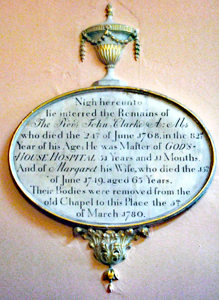 Rev John Clarke AM (1768) Master of God's House Hospital for 51 years; His wife, Margaret (1719). 'Their bodies were removed from the old chapel to this place 5th March 1780' |
 Rev Thomas Dykes LLB (1847). Founder and incumbent of St John's Church, Vicar of North Ferriby, and 14 years Master of this House. Buried at St John's with his wife, Mary (Hey) |
 William Thomas Dibb (1886) who founded the west wing in 1885. The brass below tells of his son's, Oscar Knocker Dibb, legacy to the charity in 1949 |
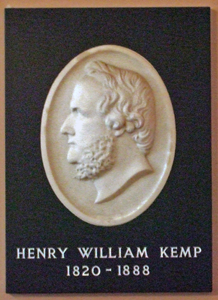 Henry William Kemp (1820-1888) |
 Rev J T Lewis MA (1898) 'For nearly eleven years Master of the Charterhouse' |
 Edward James Parkinson MA (1999) Master of this House |
| Also Rev George M Carrick (1849) by W D Keyworth | |||||
| Kirk Ella - St Andrew |
|
Ann
Seaman & others. Wall tablet of 1769; frame of
Ionic columns with inscription on a drape above
which are three oval portrait medallions which
hang from stone nails. Sir Robert Legarde (1721) Tablet Joseph (1783) and Mary Corthine (1791) Obelisks with urns William Sparks (1798) Wall tablet with medallion, seated figure and urn. Joseph Sykes (1805) He rises out of his coffin amid shattered rocks; below are various allegorical figures and symbols. By Bacon in 1809. Henry Legards (1819) and William Wilkinson (1823) Tablets with sarcophagi by Appleton Bennison Joseph Eggington (1830) Tablet by I Waudby of Hull Richard and Mary Sykes (1831) Gothick tablet Nicholas Sykes (1832) and others; Gothick tablet by Earle Joseph Sykes (1857) Portrait medallion and ship in distress by W D Keyworth Outside on wall part of 13th century cross slab. Many 19th century table tombs in the church yard. |
 |
Lockington - St Mary |
 |
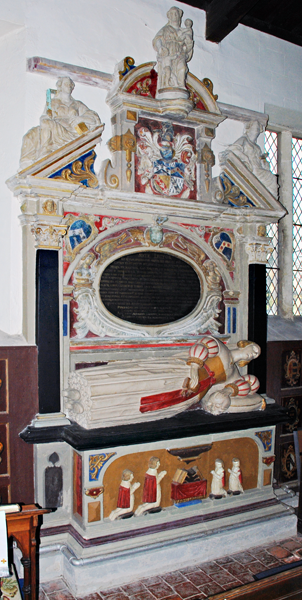 |
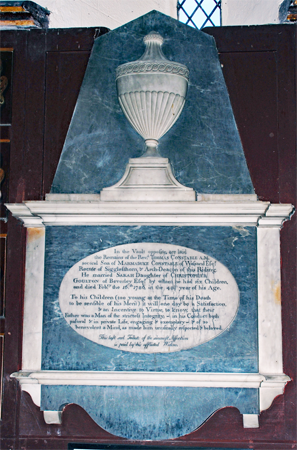 |
|
||||||||||||
| Left:
Mary Moyser
(1633) .Note the oval insciption in Latin above
the effigy, the broken pediment with allegorical figures (Truth,
Charity and Justice) and below
kneeling figures of her four sons. Above: Rev Thomas Constable (1786) Gray and white marble with oval inscription plaque. The walls around this monument were painted with 16 shields in 1634; they were restored in 1851 by William Binks for the monument of Rev Thomas Constable |
| Lodesborough - All Saints |
 |
  |
 |
||
| Rev Andrew Ewbank MA (1822)
34 Years Rector His wife: Jane (1817); their 2nd daughter, Jane Elizabeth (1816) |
Above: Richard Over (1600)
Brass now on wall. Note skull, bone, and scallop shell Below: Lady Margaret Clifford (1493) Brass set in stone |
Henry Clifford (1619) Aged 6 hours |
 |
 |
 |
 |
 |
| Earl of Burlington and Cork Possible the First Earl |
This is presumably an earlier plate which was replaced by the one on the right at some time | Rt Hon Charles Boyle PC, 2nd Earle of Burlington & 3rd Corke, Baron Clifford of Londesburgh, Baron of Younghall & Brandon, Viscount Kynalmeaky & Dungarvan. (1703) Lord High Treasurer of Ireland | Rt Hon Henry Boyle, Baron of Carleton in the County of York (1724/5) | Rt Hon Richard Boyle KG, PC, 3rd Earl of
Burlington & 4th Corke (1753) |
| The above are not brasses in the strict sense of the word but rather coffin plates, affixed to the wall of the Lady Chapel. The family is buried in a vault below the Chapel where the entrance via a slab with lifting rings may be seen. The plates were removed from the coffins in 1906 and fixed to the wall to act as memorial brasses as there were no memorials to indicate who was buried in the vault. | ||||
 |
 |
| Right:
Grisold Countess of Cumberland (1613) This
consists of a black marble slab on four 'bulbous white jars' (Pevsner).
By Nicholas Stone ((1632) The photograph only shows the
lid from above. Above: The coffin plates affixed to the wall of the Lady Chapel, not all of which have been separately recorded. |
| Also: Purbeck marble slab with brass cross in relief; 13th century |
|
|
|
Market Weighton - All Saints |
| Here are two examples of seemingly the most ordinary of monuments which have intersting tales to tell |
 |
 |
 |
 |
| Robert Barker (1748/9) and
his wife, Catherine (1773) Also three children: Robert, Rebecca, and Catherine |
Mary Evans (1776), and her husband, Bemjamin (1791) | Rev Geo. Skelding (1819) For 45 years viscar of this parish. Signed M Taylor, York |
William Bradley (1820) at 33 'He measured 7 foot, 9 inches and weighed 27 stone' |
 |
 |
 |
| Anne Pulleine (Smith) (1851) Her son, Robert James Pulleine (n/d) Her brother, John Smith (1868) |
Mary Rivis (1804) and her
sons: William Robert (1834), Iohn (1822), George (1817), & Thomas (1807) Her husband, Iohn (1844) |
Sarah Andrews (no date) In English and Spanish see below |
| Sarah Andrews |
Sarah Andrews was presumable born in Market Weighton in 1774. At some point, she became the housekeeper to General Francisco de Miranda and they later married. This was likely when he was living in London after his involvement in the French Revolution. I do not know the date of her death or where she was buried, although this was presumably in Venezuela. What a story she would have been able to tell! Click on the link of the General to find more information. The General himself was arrested and spend the last years of his life in a Spanish prison being buried in a mass grave. An empty tomb awaits him in Venezuela. |
| Pevsner: Yorkshire: York and the East Riding |
I was pleased to see that all the above monuments - with a little information about them - are included in the above volume. The would never have been the case in the original volume and I note that this particular volume has been revised by David Neave, who is a senior lecturer in history at the University of Hull and takes a more topographical approach. A welcomed change. |
 |
North Cave - All Saints |
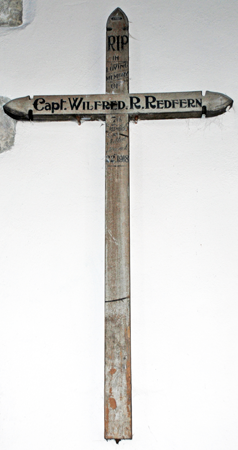 |
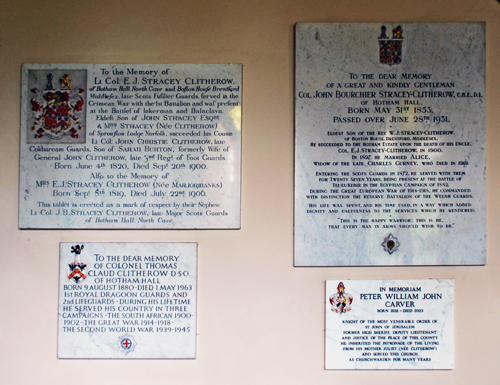 |
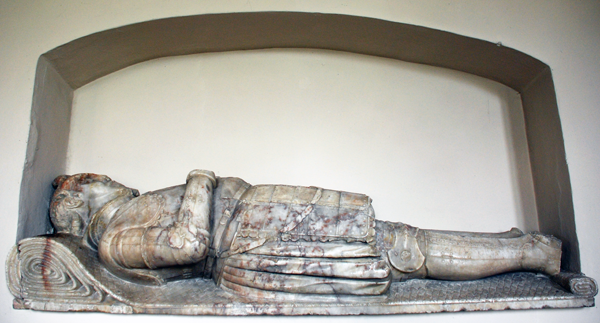 |
| Captain Wilfred R Redfern (1918) | The slightly abridged text is given below
if now readable in the photograph. Note the curious - and somewhat inconsistent use of the long s of the top left tablet |
Possibly Sir Thomas Metham (1610).
Tomb chest lost His wife's effigy is shown below a window. There is a reference to this monument on the stone shown below. |
| Lt Col E J Stracey Clatheroe (1900) Late Scots Fuſilier Guards; ſerved in the Crimea War with the 1st Battalion and waſ preſent at the Battleſ of Inkerman and Balaclava Also Mrs E J Stacey Clitherow (Marjoribanks) (1906) |
Col John Bourchier
Starcey-Clitheroe OBE DL (1931) (Nephew of Lt Col E J Stracey Clitheroe left) Served with the Scots Guards for 27 years, having been present at the Battle of Tel-El-Kebir in the Egyptian Campaign of 1882. During the Great European War of War 1914 - 1918 he commanded with distinction the Reserve Battalion of the Welsh Guards |
|
Colonel Thomas Claud Clitherow DSO (1963) 1st Royal Dragoon Guards and Second Life guards... ...he served his country in three campaigns - The South African War 1900-1902 - The Great War 1914-1918 - The Second World War 1939-1945 |
Peter William Carver (2003) Knight of the Most Venerable Order of St John of Jerusalem |
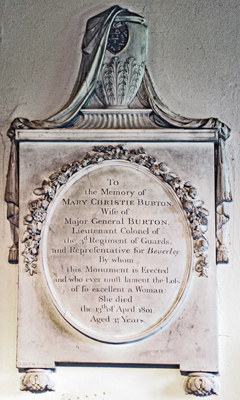 |
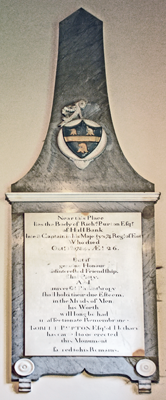 |
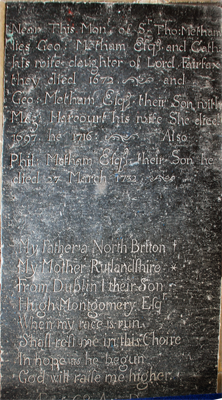 |
 |
| Mary Christie Burton (1801) Wife of Mjr Gen Burton By H. Rouw 'Modeller to His Majesty, New Road London |
Rich'd Burton (1784) Late Cpt in his Majesty's 3th Reg't of Foot |
See below for a transcript of the inscripton |
| Near this mon't of Sr Tho: Metham lies Geo: Metham Esq and Cath: his wife daughter of Lord Faiffax. they died 1672 [the second date has not been written] Geo: Metham Esq their Son with Mag Harcourt his wife She died 1697. he 1716. Also Phil: Metham Esq their Son he died 2th March 1732 |
My father a North Barton My Mother Rutlandſire From Dublin I their son Hugh Montgomery Eſsr When my race is run Shall reſt me in this Choire In hope as he begun God will raiſ me higher [the date is covered] |
| Pevsner (revised
David Neave) writes 'the ledger stones to Hugh Montgomery
(1748) Barbara Montgomery (1747) have a curious rhyming
inscriptions.' The former must refer to the stone above
and his wife presumably has a second stone. I have not
discovered the relationship of the Methams to the Mongomerys to
explain why the stone is shared. To add: 1. James Pinkerton (1781). An Adamesque frieze with scrolled pediment and urn. He was contractor for the Market Weighton canal. 2. John Foster (1816) Urn. By John Earle, Hull 3. Rev Richard Todd (1830) Also by the above 4 & 5. Nathan Jowett Baron (1841) and Sarah Baron (1844) Both by R Brown, London 6. George Barton (1854) A copy of the last by Simpson & Malone of Hull |
| Pocklington - All Saints |
 |
 |
 |
 |
| The Hon Gerald Valerian Wilson (1903) | Iris Judd (1970) | James Silburn (1829) 'Also in the same Vault in this pew the remains of Harriet Silburn...' (1844) | 'HEARE VUNDER LIETH INTERED THE CORPS OF...' Robert Southebee (1594). Alabaster |
 |
 Here Lyeth the Body of Iohn Dobson Parish Clerk 51 Years. who succeeded his Father & Grand Father in that Office & whose Great Grand Father was Vicar of this Church He was a man diligent in his Office faithfull to his Masters and courteous to all Men. He Dyed Feb 25 AD 1730 AGED 80 |
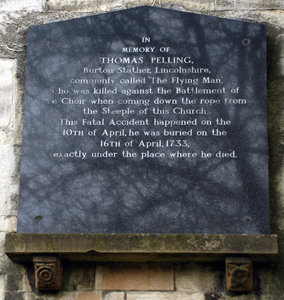 IN MEMORY OF THOMAS PELLING, Burton Stather, Lincolnshire, commonly called 'The Flying Man', who was killed against the Battlement of Ye Choir when coming down the rope from the Steeple of the Church 1733. This Fatal Accident happened on the 10th of April, he was buried on the 16th April 1733 exactly under the place where he died. The monument is outside the church and replaces the original which had become decayed |
| Thomas Dolman (1589) Black marbe triptych with incised recumbent effigies of husband and wife in centre and kneeling children on either side |
 |
 |
 |
| The Altar Rails were erected in memory of Robert Richmond Young - Warden of the Church 1924 | Robert St. John Pitts-Tucker
CBE Headmaster of Pocklington School 1945-1966 |
|
| Thomas Shield BD 41 years master of Pocklington Grammar School 1848 |
| Other Monuments | |
| Margaret Easingwold, Prioress of Wilberforce Priory. 14th Century incised slab with lead filled foliated cross. Black letter inscription added in 1512 (by pulpit) | Mid to late 14th century slab with indents for brass of head and hands of a lady. Also for figures of saints, inscription and Evangelists' symbols |
| Walter Staveley (1780) Obelisk | Seth Stables (1830) Weeping female by sarcophagus |
| Nathaniel Holmes (1835) Neoclassical by Waudby, York | Mary Dewsbury (1846) Sarcophagus and urn. by Waudby, York |
 |
Swine - St Mary |
 |
|
| Knight/Lady c. 1400 on tomb chest with shields in quatrefoils. Probably the tomb recorded which had Sutton arms in 1584; if so possibly Sir Thomas 'Lord' Sutton (c 1384) and Wife. |
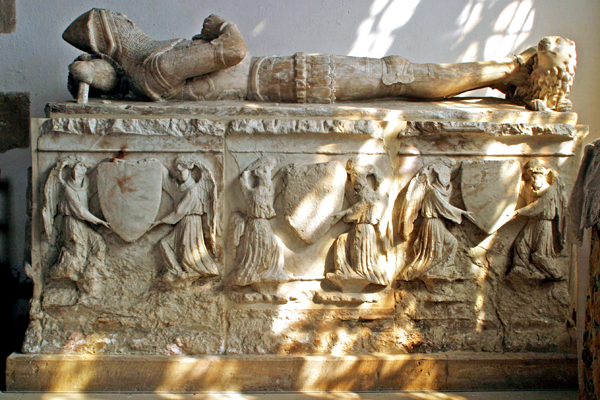 |
 |
| Knight of c 1410 on tomb chest with pairs of kneeling angels holding shields, alabaster. The base is a 13th century grave slab with incised cross. Arms of Hilton of Hilton (differenced) quartering Hilton of Swine but not indentified. |
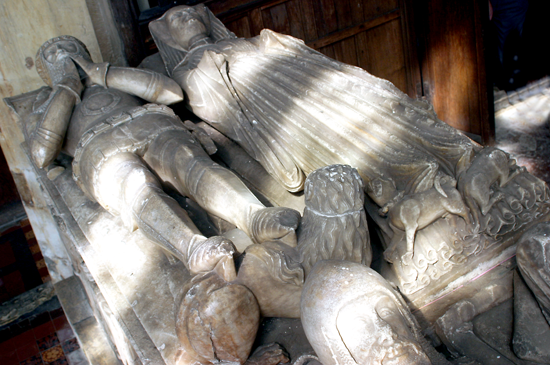 |
 |
| On the left is
a Knight/Lady of
c 1410-20, on
tomb chest with pairs of angels holding shields,
alabaster. Arms of Hilton of Swine. Either
Robert III of Swine (c
1400) and one of his wives,
or Robert IV (c
1431) and his wife Joan. On the right ( and you could just see the heads on the previous photographs) is Sir Robert Hilton (1363) & Maud (probably), knight/lady of 1360-70 on tomb chest with shields and one remaining kneeling mourner; alabaster. Arms of Hilton of Swine. Below is a close up photographs of this monument. |
|
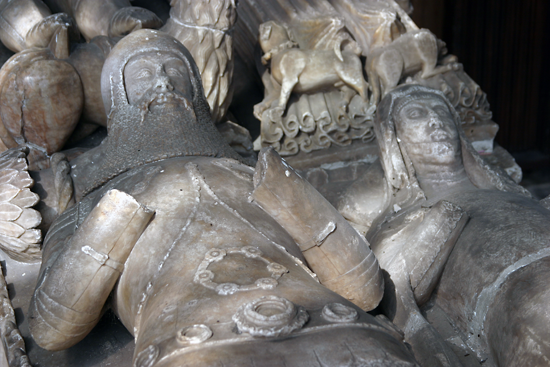 |
| This information in this section was adapted from that written and provided by Philip Lankester 2006 at the Beverely Church Monuments Society symposium that year. |
|
|
|
 |
Sledmere - St Mary |
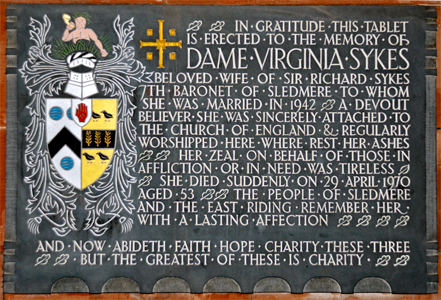 |
 |
 |
| Dame Virginia Sykes (1970) Wife of the th Baronet |
Edmund Thomas Sandars (1942) Barrister, Author and Artist |
|
|
| The Exhumation of Sir Mark Sykes |
Sir Mark had been buried in a lead lined coffin in the churchyard at Sledmere. It was believed that such a coffin would help to slow down decomposition of the body and preserve the H1N1 virus intact, so a team of virologists lead by John Oxford applied for permission to the Diocese of York for exhumation of the body. They intended to make the study under laboratory condition and to discover whether Sir Mark's death was caused by the virus itself, by a concurrent virus and bacterial infection, of by a cytokine storm in which the virus triggers an abnormal and excessive immune response with the immune system turning on and destroying the human host itself. It was hoped that all of this would help in prevention and treatment in the event of a further pandemic. Permission was generously given for this exhumation by living members of Sir Mark's family and, after a two year process, permission was finally gained form the Diocese of York. The exhumation took place in 2008. However the researchers were to be disappointed: the coffin had split owing to the weight of soil on it and the body was badly decomposed. The coffin was allowed to remain in situ and samples of lung and brain tissue were removed through the split. Soon afterwards the grave was refilled. I have not found a report on the results of this study. |
|
|
|
|
|
|
|
The drawings are by William I'Anson except fot the Percy Tomb, Beverely, which was by the Web Master and used for a symposium poster
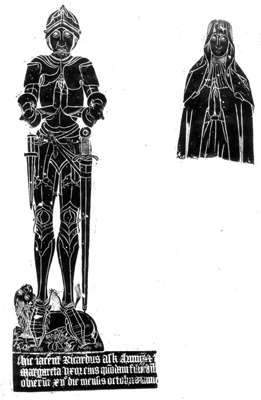




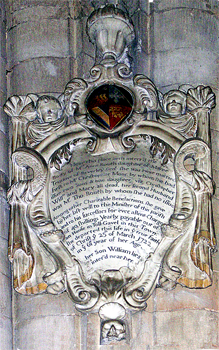
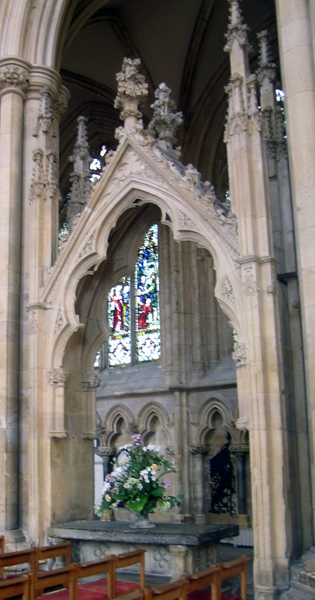
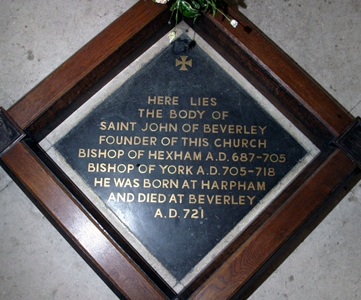
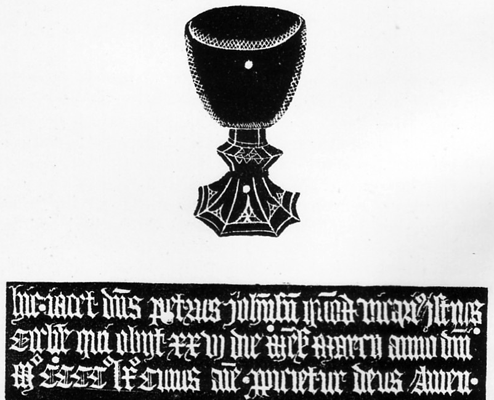
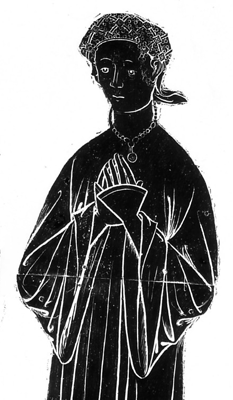
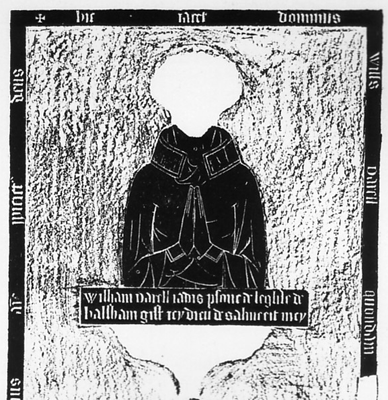
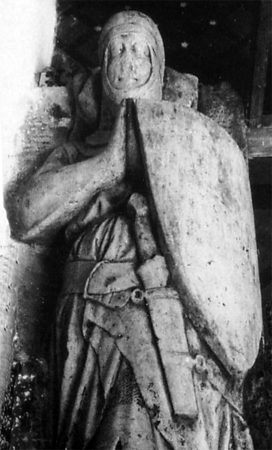
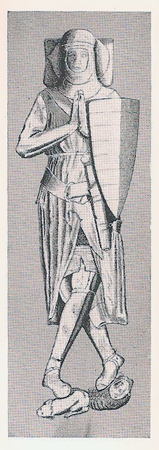

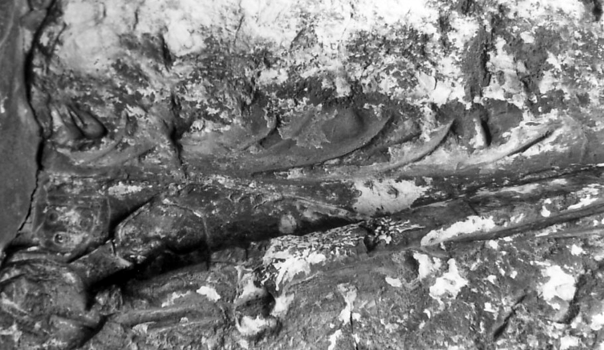 medieval effigies
in porch
medieval effigies
in porch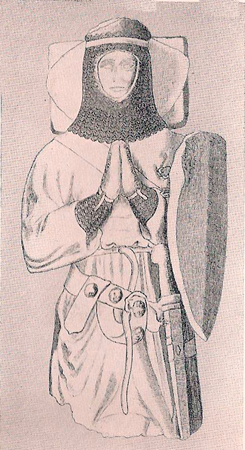 Knight (early 14th century)
(
Knight (early 14th century)
(.png)
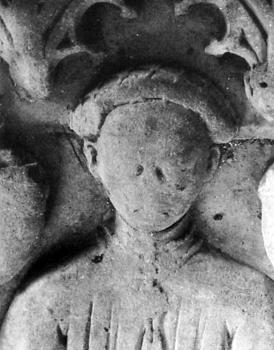
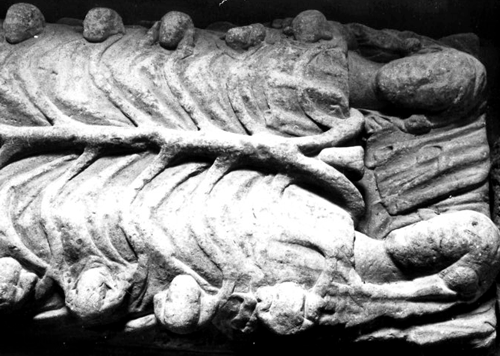

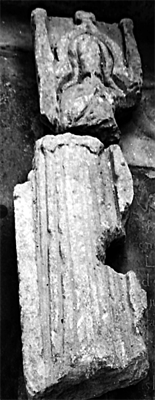
 A
de Routh, Knight & Lady
(c 1420) under double canopy. (shown)
A
de Routh, Knight & Lady
(c 1420) under double canopy. (shown) Sir John de Sutton (1357)
Effigy with straight legs on tomb chest with shields in
quatrefoils. Shield with carved arms (shown)
Sir John de Sutton (1357)
Effigy with straight legs on tomb chest with shields in
quatrefoils. Shield with carved arms (shown)

 Left: Thomas
Bridlington, Prior of Warter (1498) Found in
the excavations in 1899 and reburied so no longer
visible.
Left: Thomas
Bridlington, Prior of Warter (1498) Found in
the excavations in 1899 and reburied so no longer
visible.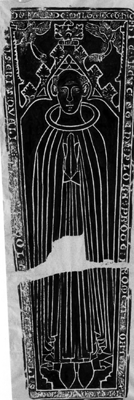
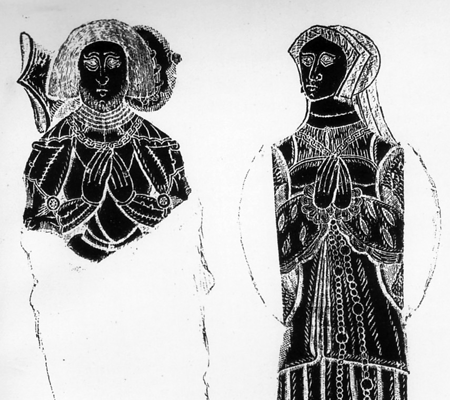
.png)
